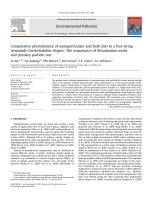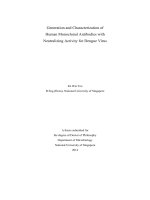Comparative characterization of microstructure and luminescence of europium doped hydroxyapatite nanoparticles via coprecipitation and hydrothermal method
Bạn đang xem bản rút gọn của tài liệu. Xem và tải ngay bản đầy đủ của tài liệu tại đây (879.89 KB, 11 trang )
Accepted Manuscript
Title: Comparative characterization of microstructure and
luminescence of europium doped hydroxyapatite
nanoparticles via coprecipitation and hydrothermal method
Author: Thang-Cao Xuan Nguyen Ngoc Trung Vuong-Hung
Pham
PII:
DOI:
Reference:
S0030-4026(15)01205-X
/>IJLEO 56341
To appear in:
Received date:
Accepted date:
10-11-2014
11-9-2015
Please cite this article as: T.-C. Xuan TrungV.-H. Pham Comparative characterization
of microstructure and luminescence of europium doped hydroxyapatite nanoparticles
via coprecipitation and hydrothermal method, Optik - International Journal for Light
and Electron Optics (2015), />This is a PDF file of an unedited manuscript that has been accepted for publication.
As a service to our customers we are providing this early version of the manuscript.
The manuscript will undergo copyediting, typesetting, and review of the resulting proof
before it is published in its final form. Please note that during the production process
errors may be discovered which could affect the content, and all legal disclaimers that
apply to the journal pertain.
Comparative characterization of microstructure and luminescence of europium doped
hydroxyapatite nanoparticles via coprecipitation and hydrothermal method
ip
t
Thang-Cao Xuana, Nguyen Ngoc Trung b, Vuong-Hung Phama, *
a
Advanced Institute for Science and Technology (AIST), Hanoi University of Science and Technology (HUST), No
01, Dai Co Viet road, Hanoi, Vietnam
b
us
cr
School of Engineering Physics, Hanoi University of Science and Technology (HUST), No 01, Dai Co Viet road,
Hanoi, Vietnam
*Corresponding author: Vuong-Hung Pham
Ac
ce
p
te
d
M
an
[Tel: +84-4-36230435, Fax: 84 43 6230 293, E-mail: ]
Keywords: nanoparticles; luminescence; hydroxyapatite, europium, hydrothermal, Nanobiophosphors
Page 1 of 10
Abstract
This paper reports the first attempt to compare the microstructure and luminescence of europium doped
hydroxyapatite (HA) nanostructure to achieve strong and stable luminescence of hydroxyapatite nanophosphor,
ip
t
particularly, by co-precipitation and hydrothermal synthesis method. The Raman spectra analysis indicates that all
modes are related to the HA phase. The morphology of Eu doped HA nano particles was depended on the
cr
synthesized method that was observed to have a nanowire structure to nanorod morphology. The creation of highly
Ac
ce
p
te
d
M
an
nanophosphor, which was potential application in nanomedicine.
us
nanocrystalline Eu-doped HA with nanorod morphology resulted in a significantly enhancing luminescence of the
Page 2 of 10
1. Introduction
Hydroxyapatite (HA) has received considerable attention in nanomedicine in designing the functional
materials because of its highly biocompatibility and easily to acceptation a wide variety of dopants based on
ip
t
flexibility of the apatitic structure [1,2]. In order to obtain a nanoparticle for potential application in bioimaging and
nanomedicine, a combination of various properties is needed: excellent biocompatiblity, photostability, sphere shape
cr
nanoparticles [3,4 ]. Therefore, considerable effort has been made to functionalize hydroxyapatite nanoparticle by
incorporation of its materials with organics dye [5,6], semiconductor quantum dots [7,8], and rare earth elements
us
[9,10]. Organics dyes conjugated into nanoparticles are considered as the effective materials for bioimaging but
there is still a risk of photobleaching and in vivo instability because organic dye placed in aqueous biological
an
environments reduces luminescent intensity over the time [11]. Another promising approach to enhance the
performance of bioimaging materials is to conjugate their materials with a semiconductor such as CdS [12], ZnSe
M
[13], and (CdSe) [14], which would not face with late photobleaching but there is still a concern of its late toxicity
[15,16].
d
As one of the rare earth elements, europium has received considerable attention as an activator for doping
te
into calcium based materials due to their exhibiting importance advantages compared with available phosphor such
as lower toxicities, photostabilities, high thermal and chemical stabilities, and high luminescence quantum yield
Ac
ce
p
[17,18]. Nevertheless, there are only a few reports on the synthesis of luminescence hydroxyapatite for potential
applications as bioimaging and nanomedicine [19, 20, 21,22]. In particular, in our knowledge, there are no reports
on the comparative characterization of the microstructure and luminescence of europium doped HA nanoparticle via
coprecipitation and hydrothermal method.
Therefore, this study reports a way of controlling the microstructure, crystallinities and light emission of
the Eu doped HA, as well as the mechanism in a variation of luminescence of two different methods. The
microstructure and chemical composition of the Eu doped HA were characterized by transmission electron
microscope (TEM). The crystal structure of the specimen was characterized by Raman spectroscopy. The
luminescence was also determined by photoluminescence
Page 3 of 10
2. Experimental procedure
Europium doped hydroxyapatite was synthesized through a coprecipitation and hydrothermal method, as
follows: an aqueous solution with stoichiometric amount of (NH4)2 HPO4 (0.2M, 99% purity, Aldrich) were added
ip
t
over an aqueous solution containing Ca (NO3)2 .4H2O (0.2M, 99% purity, Aldrich), and 0.3 mol % Eu(NO3)3.
Eu(NO3)3 were obtained by dissolving stoichiometric Eu2O3 (99% purity, Aldrich) in HNO3 with vigorous stirring.
cr
The reaction mixture was stirred for 0.5 h followed by precipitation method at 80 oC and the pH was adjusted to 11
by using aqueous ammonia. For hydrothermal synthesis, the mixture was transferred into 200 ml Teflon-lined
us
autoclave, and then the autoclave was sealed and maintained at 150 oC for 12 h. The resulting precipitates were
washed three times, and then dried at 100 oC for 6h. The crystalline structures of the Eu doped HA were
an
characterized by a micro Raman spectroscopy (Renishaw, United Kingdom). The microstructure of the Eu doped
HA was determined by field emission scanning electron microscopy (JEOL, JSM-6700F, JEOL Techniques, Tokyo,
M
Japan). Photoluminescence (PL) tests were performed to evaluate the optical properties of the Eu doped HA.
NANO LOG spectrofluorometer (Horiba, USA) equipped with 450 W Xe arc lamp and double excitation
te
3. Results and discussion
The PL spectra were recorded automatically during the measurements.
d
monochromators was used.
Ac
ce
p
Figures 1 (A) and (B) show the typical Raman patterns of the Eu doped HA processed with the variation of
synthesis method. The coprecipitation specimen of Eu doped Si-HA showed a Raman shift = ~ 962 cm-1
corresponding to the symmetric stretching ν 1 mode of PO4 3- of the crystalline hydroxyapatite, as well as peaks at
Raman shift = ~ 433 cm-1 was attributed to bending ν 2 of the PO4 3- ion (Fig. 1 (A)). On the other hand, when a
hydrothermal synthesis was applied, strong Raman peak situated at about ~ 962 cm-1 and ~ 433 cm-1 was assigned
to the to the symmetric stretching ν 1 mode of PO4 3- and bending ν 2 of the PO4 3-, respectively with additional peak
at 1054 cm -1 corresponding to the antisymmetric stretching ν 3 of the PO4 3- ion (Fig. 1 (B). These results indicate
that all Raman modes are related to the HA phase.
Page 4 of 10
Fig. 1. Raman spectra of Eu doped HA (A) co-
us
cr
ip
t
precipitation, (B) hydrothermal method.
an
The representative microstructure of the Eu doped HA nanophosphor was characterized by TEM, as shown
in Figs. 2 (A) – (D). The co-precipitation specimen showed a long nanowire microstructure (Fig. 2(A)) with length
M
up to 500 nm and diameter less than 50 nm. On the other hand, the hydrothermal specimen showed nanorod-like
morphology with aspect ratio of 5 (Fig. 2(C)), which is expected to enhance luminescence due to the high packing
d
density and reduction of light scattering. Electron diffraction (ED) revealed that all the Eu doped HA displayed
te
nanocrystal materials. However, it should be noted that the crystalline of the sample increases with the hydrothermal
method.
Ac
ce
p
synthesis method (Fig. 2(D), which is due to the application of higher synthesis temperature via hydrothermal
Fig. 2. TEM and Electron
diffraction (ED) analysis of the
Eu doped HA ((A), (B)):
coprecipitation, ((C), (D)):
hydrothermal.
Page 5 of 10
The photoluminescence of the Eu doped HA were evaluated by photoluminescence spectroscopy (PL), a
nondestructive method which is very useful for analyzing the efficiency of trapping, migration and transfer of
charge carriers and understanding the crystallization behavior of the luminescent materials [23,24]. The typical
photoluminescence spectra of the Eu doped HA are shown in Figs. 3. All the Eu doped HA showed strong visible
5
Do
F3 , 5Do
7
5
Do
F1, 5Do
7
7
F2,
ip
t
emission peaks appeared at about 590, 616, 650 and 700 nm and they can attributed to the
7
F4 transitions within Eu3+ ion, respectively. However, it should be noted that PL intensity of Eu
cr
doped HA increased with the sample prepared by hydrothermal method. It is well known that the coprecipitation
us
method that generally creates amorphous or less crystalline materials, the hydrothermal technique allows for the
creation of well-crystalline structure via higher temperature [25,26,27]. The enhancing PL intensities of Eu doped
an
HA should be mainly due to their well-crystalline of the sample prepared by hydrothermal method.
Fig. 3. Photoluminescence spectra of Eu
hydrothermal method.
Ac
ce
p
te
d
M
doped HA with coprecipitation and
4. Conclusions
We herein demonstrated that the photoluminescence of hydroxyapatite could be obtained effectively by
doping with rare earth europium. The Raman spectra analysis indicates the formation of HA single phase.
Photoluminescence intensity of the Eu doped HA increases on the sample prepared by hydrothermal method with
the characteristic emission of Eu 3+. This enhancement of the PL was mainly attributed to the particle morphology
Page 6 of 10
and well-crystalline material via hydrothermal method. These phosphors show potential application in
nanomedicine where require a combination of biocompatibility and light emission.
Acknowledgment
ip
t
This research is funded by Vietnam National Foundation for Science and Technology Development
(NAFOSTED) under grant number “103.99-2013.05”. Author acknowledges technical support for TEM imaging
cr
from Bui Van Dong, Geology, Geotechnique, Geo-environment Climate Change lab, Vietnam National University.
us
References
[1] A.A. Chaudhry, S. Haque, S. Kellici, P. Boldrin, I. Rehman, F.A. Khalid, J.A. Darr, Instant nano-hydroxyapatite:
an
a continuous and rapid hydrothermal synthesis, Chem. Commun 4 (2006) 2286-2288.
M
[2] C. Yang, P. Yang, W. Wang, S. Gai, J. Wang, M. Zhang, J. Lin, Synthesis and characterization of Eu-doped
hydroxyapatite through a microwave assisted microemulsion process, Solid State Sci 11 (2009) 1923-1928.
d
[3] M. Liong, J. Lu, M. Kovochich, T. Xia, S.G. Ruehm, A.E. Nel, F. Tamanoi, J.I. Zink, Multifunctional inorganic
te
nanoparticles for imaging, targeting, and drug delivery, ACS Nano 2 (2008) 889-896.
Ac
ce
p
[4] Y.N. Xia, Nanomaterials at work in biomedical research. Nat. Mater 7 (2008) 758-760.
[5] X. Ge, C. Li, C. Fan, X. Feng, B. Cao, Enhanced photoluminescence properties of methylene blue dye
encapsulated in nanosized hydroxyapatite/silica particles with core-shell structure, Applied Physics A 113 (2013)
583-589.
[6] T.T. Morgan, H.S. Muddana, E.I. Altinoğlu, S.M. Rouse, A. Tabaković, T. Tabouillot, T.J. Russin, S.S.
Shanmugavelandy, P.J. Butler, P.C. Eklund, J.K. Yun, M. Kester, J.H. Adair, Encapsulation of organic molecules in
calcium phosphate nanocomposite particles for intracellular imaging and drug delivery, Nano Lett 8 (2008) 41084115.
[7] R. Zhou, M. Li, S. Wang, P. Wu, L. Wu, X. Hou, Low-toxic Mn-doped ZnSe@ZnS quantum dots conjugated
with nano-hydroxyapatite for cell imaging, Nanoscale 6 (2014) 14319-14325.
Page 7 of 10
[8] Y. Guo, D. Shi, J. Lian, Z. Dong, W. Wang, H. Cho, G. Liu, L. Wang, R. Ewing, Quantum dot conjugated
hydroxyapatite nanoparticles for in vivo imaging, Nanotechnology 19 (2008) 175102-175108.
[9] C. Yao, Y. Tong, Lanthenide ion-based luminescent nanomaterials for bioimaging. Trend Analy.Chem 39 (2012)
ip
t
60-71.
[10] Y. Sun, H. Yang, D. Tao, Microemulsion process synthesis of lanthanide-doped hydroxyapatite nanoparticles
cr
under hydrothermal treatment. Ceram. Int 37 (2001) 2917-2920.
us
[11] K.J. Lanmark, S. Dimaggio, J. Ward, C.V Kelly, S. Vogt, S. Hong, A. Kotlyar, A. Myc, T.P. Thomas, J.E.
Penner-Hahn, J.R. Baker, M.M. Holl, B.G. Orr, Synthesis, characteristic, and in vitro testing of superparamagnetic
an
iron oxide nano-particles targeted using acid-conjugated dendrimers. ACS nano 2 (2008) 773-783.
toxicity profiles. Langmuir 23 (2007) 12783-12787.
M
[12] N. Ma, J. Yang, K.M. Stewart, S.O. Kelley, DNA-passivated CdS nanocrystals: Luminesence, bioimaging, and
[13] S.J. Soenen, B.B. Manshian, T. Aubert, U. Himmelreich, J. Demeester, S.C. De Smedt, Z. Hens, K.
te
(2014) 1050-1059.
d
Braeckmans, Cytotoicity of cadmium-free quantum dots and their use in cell bioimaging. Chem. Res. Toxicol 27
Ac
ce
p
[14] M.J. Murcia, D.L. Shaw, E.C. Long, C.A. Naumann, Fluorescence correlation spectroscopy of CdSe/ZnS
quantum dot optical bioimaging probes with ultra-thin biocompatible coatings, Opt. Commun 281 (2008) 1771-1780.
[15] A.M. Derfus, W.C.W. Chan, S.W. Bhatia, Probing the cytotoxicity of semiconductor quantum dots, Nano
Letters 4 (2004) 11-18.
[16] A. Shiohara, A. Hoshino, K. Hanaki, K. Suzuki, K. Yamamoto, On the cyto-toxicity caused by quantum dots.
Microbio. Immuno 48 (2004) 669-675.
[17] G.F. Wang, Q. Peng, Y.D. Li, Lanthanide-doped mamo-crystals: synthesis, optical-magnetic properties, and
application, Acc. Chem. Res 44 (2011) 322-332.
Page 8 of 10
[18] A. Escudero, M.E. Calvo, A. Rivera-Fernández, J.M. de la Fuente, Microwave-assisted synthesis of
biocompatible europium-doped calcium-hydroxyapatite and fluoroapatite luminescence nanospindles functionalized
with poly (acrylic acid), Langmuir 29 (2013) 1985-1994.
ip
t
[19] C. Yang, P. Yang, W. Wang, S. Gai, J. Wang, M. Zhang, J. Lin, Synthesis and characterization of Eu-doped
hydroxyapatite through a microwave assisted microemulsion process, Solid State Sci 11 (2009) 1923-1928.
cr
[20] O. Graeve, R. Kanakala, A. Madadi, B.C. William, K.C. Glass, Luminescence variation in hydroxyapatites with
us
Eu2+ and Eu3+, Biomaterials 31 (2010) 4259-4267
[21] S. Huang, J. Zhu, K. Zhou, Effect of Eu3+ ion on the morphology and luminescence properties of
an
hydroxyapatite nanoparticles synthesized by one-step hydrothermal method, Mater. Res. Bull 47 (2012) 24-28.
[22] F. Chen, P. Huang, Y.J. Zhu, J. Wu, C.L. Zhang, D.X. Cui, The photoluminescence, drug delivery and imaging
M
properties of multifunctional Eu3+/Gd3+ dual-doped hydroxyapatite nanorods, Biomaterials 32 (2011) 9031-9039.
[23] R.J. Wiglusz, R. Pazik, A. Lukowiak, W. Strek, Synthesis, structure, and optical properties of LiEu(PO3)4
te
d
nanoparticles, Inorg. Chem 50 (2011) 1321-30.
[24] D. Fang, Z. Luo, S. Liu, T. Zeng, L. Liu, J. Xu, Z. Bai, W. Xu, Photoluminesence properties and
Ac
ce
p
photocatalytics activities of zirconia nanotube arrays fabricated by anodization, Opt Mater 35 (2013) 1461-146.
[25] C. Liu, Y. Huang, W. Shen, J. Cui, Kinetics of hydroxyapatite precipitation at PH 10 to 11, Biomaterials 22
(2001) 301-306.
[26] R.S. André, E.C. Paris, M.F.C. Gurgel, I.L.V. Rosa, C.O. Paiva-Santos, M.S. Li, J.A. Varela, E. Longo,
Structural evolution of Eu-doped hydroxyapatite nanorods monitored by photoluminescence emission, J. Alloys.
Com 531 (2012) 50-54.
[27] A. Aninian, M. Solati-Hashjin, A. Samadikuchaksaraei, F. Bakhshi, F. Gorjipour, A. Farzadi, F. Moztarzaleh,
M. Schmücker, Synthesis of silicon-substituted hydroxyapatite by a hydrothermal method with two different
phosphorous sources, Ceram. Int 37 (2011) 1219-1229.
Page 9 of 10
Figures
Fig. 1. Raman spectra of Eu doped HA (A) co-precipitation, (B) hydrothermal method.
Fig. 2. TEM and Electron diffraction (ED) analysis of the Eu doped HA ((A), (B)): coprecipitation, ((C), (D)):
ip
t
hydrothermal.
Ac
ce
p
te
d
M
an
us
cr
Fig. 3. Photoluminescence spectra of Eu doped HA with coprecipitation and hydrothermal method.
Page 10 of 10









